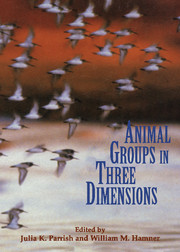Book contents
- Frontmatter
- Contents
- List of contributors
- Acknowledgments
- 1 Introduction – From individuals to aggregations: Unifying properties, global framework, and the holy grails of congregation
- Part one Imaging and measurement
- Part two Analysis
- Part three Behavioral ecology and evolution
- Part four Models
- 16 Conceptual and methodological issues in the modeling of biological aggregations
- 17 Schooling as a strategy for taxis in a noisy environment
- 18 Trail following as an adaptable mechanism for popular behavior
- 19 Metabolic models of fish school behavior – the need for quantitative observations
- 20 Social forces in animal congregations: Interactive, motivational, and sensory aspects
- References
- Subject index
- Taxonomic index
17 - Schooling as a strategy for taxis in a noisy environment
from Part four - Models
Published online by Cambridge University Press: 01 June 2010
- Frontmatter
- Contents
- List of contributors
- Acknowledgments
- 1 Introduction – From individuals to aggregations: Unifying properties, global framework, and the holy grails of congregation
- Part one Imaging and measurement
- Part two Analysis
- Part three Behavioral ecology and evolution
- Part four Models
- 16 Conceptual and methodological issues in the modeling of biological aggregations
- 17 Schooling as a strategy for taxis in a noisy environment
- 18 Trail following as an adaptable mechanism for popular behavior
- 19 Metabolic models of fish school behavior – the need for quantitative observations
- 20 Social forces in animal congregations: Interactive, motivational, and sensory aspects
- References
- Subject index
- Taxonomic index
Summary
Introduction
One of the most basic problems confronting aquatic organisms is locating favorable regions within their fluid environment that contain appropriate levels of resources such as food, oxygen, and sunlight. Because limiting resources typically have “patchy” distributions in which concentrations may vary by orders of magnitude, success or failure in finding favorable areas often has an enormous impact on growth rates and reproductive success. To locate resource concentrations, many aquatic organisms display tactic behaviors, in which they orient with respect to local variations in chemical stimuli or other environmental properties. Taxes may be based on a variety of cues, including temperature, salinity, chemical constituents such as odorant plumes, and population density of small organisms such as phytoplankton. These material fluid properties are dispersed in the aquatic environment in a non-uniform and irregular way, through the combined effects of molecular diffusion, turbulent transport, and density stratification (Atema 1988). Through these processes, cues for taxis may take on a convoluted, three-dimensional structure, with fluctuations in concentration at both large and small length scales (Nihoul 1981 Monin & Ozmidov 1985). Aquatic organisms attempting to use local variations in material properties to locate patches of resource concentrations thus frequently face a formidable task. Here, I propose that schooling behaviors improve the tactic capabilities of school members and enable them to climb faint and noisy gradients which they would otherwise be unable to follow.
A large literature exists on the evolutionary benefits and costs of social aggregative behavior. Social behavior is thought in many cases to confer protection from predation and to enable unsuccessful foragers to exploit resources discovered by fellow group members, while subjecting group members to intensified intragroup competition (Clark & Dukas 1994).
- Type
- Chapter
- Information
- Animal Groups in Three DimensionsHow Species Aggregate, pp. 257 - 281Publisher: Cambridge University PressPrint publication year: 1997
- 13
- Cited by



